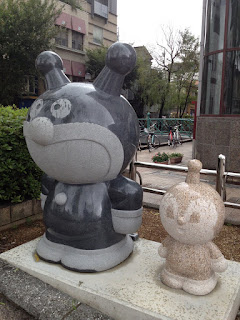Kochi is a small, quiet city. It's about as far off the beaten path as big cities can go. A single transportation route from Kagoshima at the southern end of Kyushu up to Aomori and even Sapporo and Wakkanai at the northern tip of Hokkaido can be drawn. It runs through almost every important city in Japan - Kagoshima Fukuoka, Hiroshima, Okayama, Himeji, Kobe, Osaka, Kobe, Nagoya, Yokohama, Tokyo, Sendai, Morioka, Hachinohe, Aomori, Hakodate, Sapporo, and finally Wakkanai. Shikoku doesn't figure in that route at all, and far off that line is Kochi.
It is a coastal town, though, and as such could be reached by ships traveling north and south traveling through the Pacific Ocean. And today, it remains quiet and fairly isolated, with a fairly flat main area.
One thing I noticed very quickly was Anpanman. Kochi is home to an Anpanman Museum, and the streetcar at the top of this post and these benches near the main train station are a constant reminder of that fact.
Kochi is known for several locally-produced goods (what town in Japan isn't?) including naruko. That giant red, black, and yellow wooden "toy" was originally created to keep birds away from rice crops, and are primarily used in dance festivals today.
The train station has a visitor's center that showcases a lot about the region's history, though English signage was minimal.
Kochi is another town with a proud history of samurai, including Sakamoto Ryoma. There is a museum telling his story and about Kochi in town, and these three large statues watch over Kochi from the train station. I didn't visit because I didn't know about it at the time, but there are some free samurai residences near Kochi Castle.
There is a large pedestrian shopping arcade about a ten minute walk from the station. There's a tourist attraction nearby, and the castle is about 10 minutes away as well.
Don't be surprised when I tell you Kochi has a mascot. Everything in Japan has a mascot. I wonder if any mascots have mascots. Anyway, he's modeled after that naruko Kochi is apparently known for.
There's a small river running parallel to the shopping street. Nearby is that tourist attraction, but you'll also find more statues of Anpanman characters along the main streets. I believe those are whales in the water, a nod to Kochi's maritime history.
Hello Kitty is everywhere, including on Harimayabashi! There's a story about this small bridge that draws Japanese visitors to the site.
A priest from the nearby temple of Godaisan (where relationships aren't allowed) and a girl from Kochi met in secret and had a forbidden romance. They would exchange small gifts; one day the priest was seen buying a comb here and their affair was discovered. The story says the two fled the city to avoid punishment. Of course, you can buy hair combs at the shopping arcade along with your own naruko.
Anpanman. Is. Everywhere. I really don't know much about the show, other than it's unbelievably popular even after all these years (how?!) and the characters are all pieces of bread. I call the sliced bread guy Powdered Toast Man because of the character on Ren & Stimpy (which was probably created because of this show).
The heavy rains Shikoku suffered during my stay threatened the safety of the railway and closed my route home. Luckily I was able to buy a bus ticket and get back to my hotel that night.
Kochi wasn't a planned stop, so I feel like I missed out on some things I would have seen if I had prepared a bit more. Those samurai houses would have been a definite stop, and I might have stopped at the local museum of art, the Sakamoto museum, and possibly even the Anpanman museum.
Additionally, Kochi is known for a bonito (shipjack tuna) dish called katsuo no tataki, It looks pretty good, but timing and uncertainty of travel meant that I couldn't stay for dinner. I don't even remember having lunch there! I probably grabbed a sandwich and ate on the train ride to Kochi.
Anyway, access is not so tough from Okayama (2.5 hours) and other cities in Shikoku, though getting in from Shikoku cities might require changing trains somewhere like Marugame. In town, there are two tram lines that can help those not keen on walking get around the main sights.
Getting out to Mount Godaisan, where a temple and botanical garden are located, and beyond to Katsurahama Beach, where the Sakamoto Ryoma museum is, requires a bit more time. The best way to access both is with the My Yu Bus. A day pass is 1000 yen (only 500 yen for foreign tourists, passport required) and will let you get to both sites fairly easily. My Yu buses run about once every one or two hours.



















Anpanman has been around since I was a kid... and that's a long, long time. Those three samurai statues are very, very cool.
ReplyDeleteAnpanman and Doraemon are both really long-running anime. I can't think of children's programming in the US like that anymore, other than Sesame Street. Mr. Rogers and Mr. Wizard were around when I was a kid and had quite long runs, but they are gone, of course.
ReplyDeleteWhen I mention Kochi to one of my students here, they always ask about Sakamoto and the statues - certainly a well-known story and landmark.